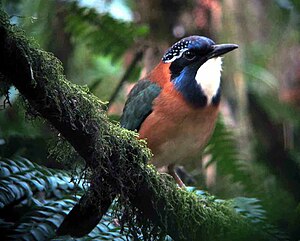Blue-headed Erdracke
| Blue-headed Erdracke | ||||||||||
|---|---|---|---|---|---|---|---|---|---|---|

Blue-headed Erdracke ( Atelornis pittoides ) |
||||||||||
| Systematics | ||||||||||
|
||||||||||
| Scientific name | ||||||||||
| Atelornis pittoides | ||||||||||
| ( Lafresnaye , 1834) |

The blue head Erdracke ( Atelornis pittoides ) is endemic to Madagascar occurring bird from the family of the ground roller (Brachypteraciidae).
features
Blue-headed Erdracken reach a body length of 25 to 29 centimeters. The weight of the male fluctuates between 83.0 and 89.5 grams, that of the female between 87.0 and 108.0 grams. The birds are very colorful and show the following plumage colors:
- Head: cobalt blue with small white speckles
- Over-eye stripe : white
- Reins: Black and very broad
- Throat: bordered in bright white and dark blue
- Chest, neck and flanks: orange
- Belly: cream colored
- Arm , hand swing and control springs : olive green
There is no sexual dimorphism between the sexes . The females show almost identical drawing patterns as the males, but are slightly larger and heavier. The bill is blackish in both sexes, the iris dark brown. The relatively long legs have a light reddish color.
voice
The territorial call consists of a piercing, monosyllabic and high-pitched 'wuub' sounding tone that lasts about 0.5 seconds and is repeated 5 to 20 times. The call is usually made at dawn, but also in the morning or evening.
distribution and habitat
The distribution area of the blue-headed Erdracke covers large areas almost on the entire east side of Madagascar. It prefers to colonize forests overgrown with dense herbaceous layers up to heights of 2000 meters, mostly between 800 and 1600 meters.
Way of life
The birds feed primarily on various invertebrates , such as ants , beetles , butterflies , grasshoppers and worms . Occasionally small vertebrates are also preyed on, for example chameleons or frogs . The prey animals are mostly looked for on the ground. Blueheaded terriers also hunt at dusk and sometimes at night. The main breeding season falls from October to February. The couples live monogamous and settle in fixed territories. The nest cavity is dug into the ground. The downward sloping access tube is approximately 0.5 to 1.0 meters long. At the end there is a nest chamber with a diameter of around 20 centimeters, which is padded with dry vegetation. The nest is provided with two to four shiny white eggs that the female hatches. It is supplied with food by the male on the nest. After hatching, the young are fed by both parents. Information on the breeding and nestling times is not available.
Danger
The blue-headed Erdracke is widespread in the national parks in eastern Madagascar and the adjacent areas. Despite the reclamation of some of its habitats, it is hardly in decline and is therefore classified by the IUCN as a ![]() “ least concern ”.
“ least concern ”.
Individual evidence
- ↑ a b c d e O. Langrand & GM Kirwan (2017). Pitta-like ground-roller (Atelornis pittoides). In: J. del Hoyo, A. Elliott, J. Sargatal, DA Christie & E. de Juana (eds.). Handbook of the Birds of the World Alive. Lynx Edicions, Barcelona. (accessed at http://www.hbw.com/node/55867 on March 19, 2017).
- ↑ occurrence
- ^ IUCN Red List
literature
- Josep del Hoyo , Andrew Elliott, Jordi Sargatal : Handbook of the Birds of the World, Mousebirds to Hornbills. Volume 6, Lynx Edicions, 2001, ISBN 978-84-87334-30-6 .
Web links
- worldbirdnames - IOC World Bird List
- Blue-headed Erdracke (Atelornis pittoides) in the Encyclopedia of Life . Retrieved August 11, 2017.